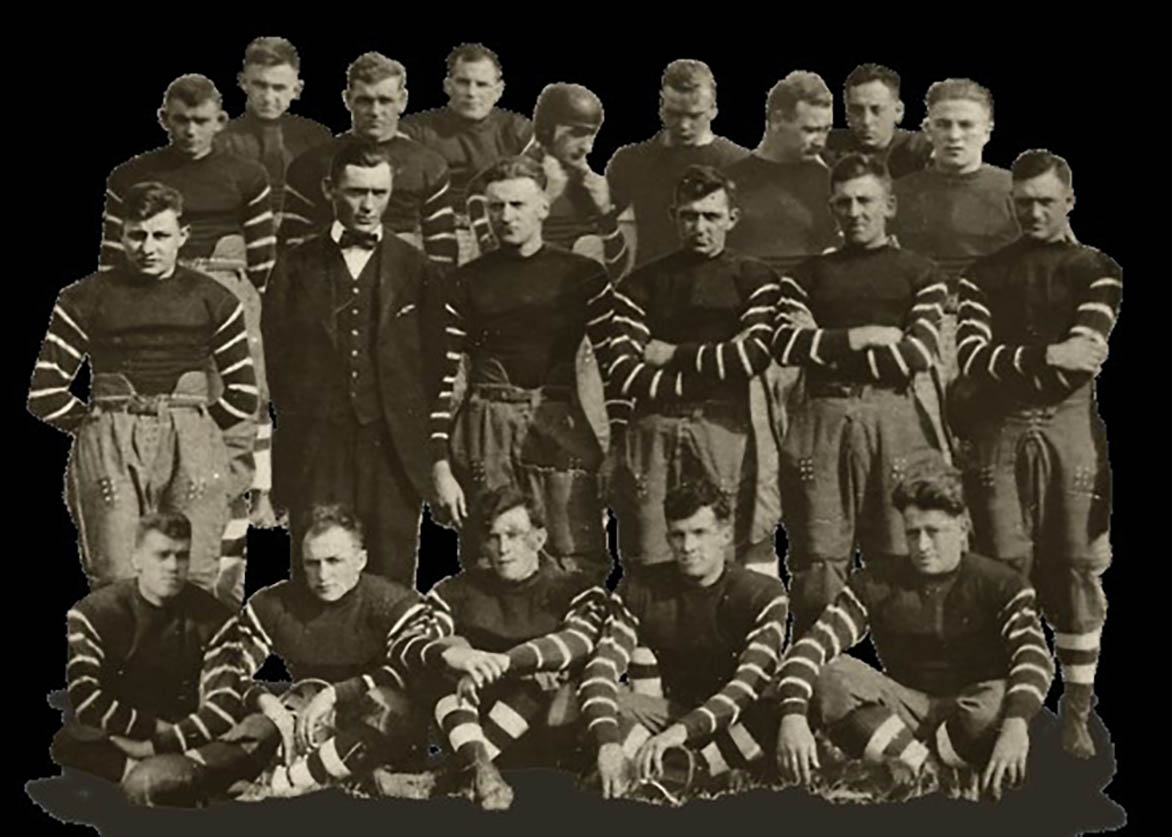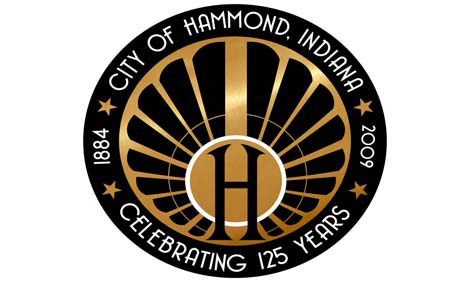| 
The 1920 Hammond Pros (Photo source: NFL.com)
Updated April 26, 2023
Hammond’s contribution to the birth of the National Football League
By WES LUKOSHUS
Chair, Steering Committee
Hammond Sports Hall of Fame
On Thanksgiving day of 1919, a professional football team from Hammond, Indiana battled a highly regarded outfit from Canton, Ohio, led by the great Jim Thorpe, to a 3-3 tie.
The game, played in Chicago at a Wrigley Field then called Cubs Park, was a holiday exhibition heaped in curiosity that produced a sweet taste of anticipation.
The 1919 Canton Bulldogs, a formidable unit that had competed throughout the 1910s in the well-regarded Ohio League, were unbeaten and untied when they took the field against Hammond.
Conversely, Hammond was essentially a traveling team that played “home” games primarily in Chicago. During 1919, Hammond reportedly compiled a season record of 4 victories, 2 defeats and 3 ties.
According to David Maraniss’ book, “Faith Lit by Lightning The Life of Jim Thorpe,” the Canton team bus en route to Chicago for the Hammond game broke down upon its arrival into town. So Thorpe and teammates proceeded to hoof it to the nearest El station and take the train to Cubs Park.
Hungry for pro football
At age 32, Thorpe—the 1912 Olympics decathlon and pentathlon gold medalist who also had played major league baseball for legendary manager John McGraw’s New York Giants—was approaching the descending side of his storied football career, but still was very much a fan favorite.
Back in the day, though a few professional leagues existed, American football’s national popularity resonated at the collegiate level. But on this early 20th century Thanksgiving day, when a non-descript Hammond team would play an undefeated Jim Thorpe-led contingent to a draw, arguably, the most compelling statistic of this relatively meaningless gridiron tussle was the throng of 12,000 fans who had delayed their Thanksgiving dinner to attend.
In fact, some football visionaries claimed the National Football League “unofficially” was conceived on that 1919 day of thanks. One sharing such a sentiment was a player who had suited up for Hammond named George Halas.
Halas would go on to hitch his football wagon the following year with the Decatur (Ill.) Staleys, which eventually became the Chicago Bears. But impressed by the response to Thanksgiving professional football in Chicago, Halas, according to the book, “America’s Game; The NFL at 100,” wrote a letter to the owner of the Canton Bulldogs. The letter spurred a meeting the following August to explore establishment of a major professional football league.
Hammond Pros, a charter member
When representatives of 11 pro football organizations from the Midwest and New York state, including the Hammond Pros and owner Dr. Alva Young, gathered in Canton, Sept. 17, 1920, major league professional football officially became established as the American Professional Football Association (APFA)—renamed the National Football League two years later.
Subsequently, the Hammond Pros became an NFL charter member and Dr. Young, an NFL founder. Though a late arrival at the meeting due to an out-of-town, minor league baseball game he had played earlier that day, Thorpe, to foster prominence and credibility, was named the new league’s first president—player-president, actually, as he would continue competing for the Canton franchise.
One of Thorpe’s initial acts as president was to appoint Hammond’s Dr. Young as chair of an executive committee to draft a league constitution of rules and regulations.
Just two weeks later, the APFA (NFL) began its first season of play!
Joining Hammond were franchises from Akron, Canton, Cleveland, Dayton, Columbus, Detroit, Muncie, Buffalo, Racine, Rock Island, Chicago, as well as Halas’ Decatur Staleys.
As described in “America’s Game…,” the debut of the APFA was a far cry from today’s high octane, extensively branded National Football League. Teams did their own scheduling in 1920 with no apparent regard or regulation to consistency of number of games played.
Maraniss wrote in his book that one objective of the new league was to rein in the “haphazard, free-for-all” operations of previous pro football leagues that saw “players coming and going at will to the highest bidder, sometimes week by week, teams rising and falling and folding . . .”
Jim Thorpe, Fritz Pollard
In addition to Thorpe, who had been a college sensation at tiny Carlisle Indian School, the new league featured Fritz Pollard, an Ivy League collegiate running back star at Brown University and just the second African American named to the Walter Camp Collegiate All-America team. Pollard would go on to become one of the great pioneers of the NFL.
During the APFA/NFL’s premiere season, Pollard was a marked man racially on and off the field. Nonetheless, he led his Akron Pros to the league’s first team championship, defeating Thorpe’s Canton Bulldogs and Halas’ Decatur Staleys twice each.
The following season, Pollard added coaching to his responsibilities with Akron, making him the NFL’s first African-American head coach.
7-season legacy for Hammond Pros
As for the Hammond Pros, there would be no league titles or anything close during the team’s seven-season existence. Operating essentially as a semi-pro outfit comprised of local players who fit football around full-time jobs, Hammond compiled a 2-5 record during its first season and just a 5-26-4 overall mark.
A franchise pretty much without a home, Hammond played precious few games within Hammond’s borders. One regular season NFL game the Pros did play in Hammond, however, is reported to have occurred in 1923, a 7-0 defeat to Dayton, purportedly at Turner Park.
Per Dr. Young’s leadership and support, the Hammond Pros’ NFL run lasted from 1920 through ’26. The end for Hammond and the Pros transpired when the rival American Football League folded its operation after its 1926 season. The action prompted the NFL to make a strategic business decision of addition by subtraction—eliminating smaller, less profitable franchises and travel teams to nurture a leaner, more financially secure league.
Still, two other noteworthy facts will forever dot the history of the Hammond Pros’ legacy:
· Pollard, the NFL’s first African American head coach, also played for and coached Hammond during part of the 1925 season, and
· six of the nine African American players who competed in the NFL during its formative seasons of the 1920s played for Hammond.
|


